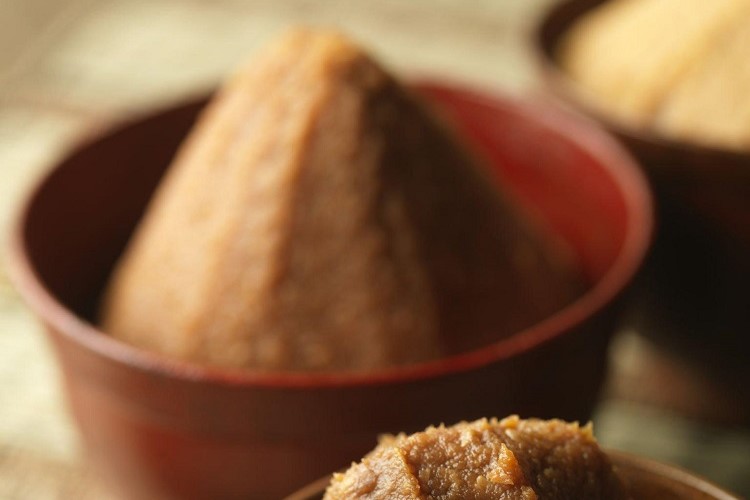Are you a fan of miso or soybean paste? Have you asked yourself which is better, such as Miso vs soybean paste?
Do you want to know the ingredients used in making both delicacies? Have you ever wondered about the similarities and differences between both treats?
This article is a sure read if you have found yourself in such a position.
Soybean paste and Miso are made from soybeans, but Miso is fermented for as long as two years. This changes the flavor and composition, creating what the Japanese call “umami” – a savory flavor.
On the other hand, Soybean paste (Korean doenjang or Chinese doujiang) is a fermented bean paste with a more pungent smell and stronger taste than Japanese Miso.
Learn more about Miso vs Soybean paste, its significant differences, and benefits.
What is Miso?

Miso is a fermented soybean paste that is well-known in Japanese cuisine. It is prepared by mixing soybeans with salt, koji (a specific moldy rice used for various Japanese culinary purposes), beans, chickpeas, or other grains.
The strength of your flavor is determined by the time of fermentation. The longer the fermentation period of the basic ingredients, the stronger the flavor of your Miso.
If there is one thing Miso is known for, it is its salty, tangy, strong umami flavor. Miso paste is usually used in small quantities because of its potency.
If you want your Miso’s shelf life to last, then there is a need to extend its fermentation period.
Miso is so much more than soup! And it prides itself on being so much more than the name of a delicious savory soup.
Types
There are 3 kinds of Miso: white, yellow, and red. They all have fermented soybeans as a key ingredient, but their difference is in the grain used.
White Miso is made with rice, while yellow and red Miso is usually made with barley: the longer Miso ages, the more its flavor increases.
It takes a few weeks for white miso to age, while red miso takes at least a year to age.
What is Soybean Paste?

Soybean paste, also called Korean doenjang or Chinese doujiang, is a fermented bean paste made of soybean and brine, making its smell more pungent and taste stronger than Japanese Miso.
Its preparation involves overnight soaking and coarse grounding, and cube shaping. The cubes are cooled and dried.
Once the cubes solidify, they’re left to ferment for several months in earthenware pots. But unlike Miso, the lids are kept off so air can reach it. This is the second phase of fermentation.
90% of the moisture is eliminated from the paste and then put back into the pots to ferment for a third time.
Soybean paste is an essential ingredient in soybean soup, and it can also be eaten as a condiment for vegetables and dipping.
It can also be mixed with garlic and sesame oil to produce ssamjang, popular among Korean meat dishes.
Soybean paste doesn’t use grain at the start of its fermentation process and uses 3 fermentation processes to get a finished paste. Whereas, Miso makes use of rice or barley with koji mold to start fermentation.
Miso Vs Soybean Paste
There are some similarities between these two delicacies like
- Both are fermented food products
- Both foods are made using fermented soybeans and salt
They also share some differences, like Miso being made by adding a koji starter to rice and the soybeans making Miso have a sweeter taste.
In contrast, doenjang or soybean paste has a sharper, more robust, and more complex flavor profile!
The major differences between soybean and Miso paste include
| Soybean paste | Miso paste |
| Made purely of soybeans and saltwater | It makes use of rice or barley with a koji mold as the base |
| It has 3 fermentation stages and is fermented in the open air at all stages | Fermentation occurs on the grain first and has 2 fermentation stages, where the second stage occurs without oxygen present |
| Boiled and mashed soybeans are added right from the start and are the base of fermentation | Boiled and mashed soybeans are only added at the second stage after the rice or barley has had time to ferment |
Benefits of Miso and Soybean Paste
Fermented food products confer health benefits, and Miso and soybean paste are no different. They’re perfect for the gut and have anti-obesity, anti-diabetic, anti-cancer, and anti-inflammatory properties.
Doenjang or Soybean paste
For centuries, Doenjang has been a staple of Korean food. It has become more popular due to its numerous health benefits.
- It contains all essential amino acids, making it a complete protein.
- It helps stimulates the secretion of digestive fluids.
- Doenjang contains high antioxidants, such as isoflavones, that can help protect the body against damage from free radicals and reduce the risk of chronic diseases such as cancer and heart disease.
- Doenjang contains compounds called saponins, which may help lower cholesterol levels in the blood.
- In addition to vitamin K, magnesium, potassium, and calcium, Doenjang is a good source of vitamin K, magnesium, and potassium.
- Doenjang has ACE inhibitory effects, which aid in preventing increased blood pressure.
- In addition to being a traditional condiment, doenjang is an anti-diabetic and anti-inflammatory health food made from soybeans and salt.
Miso
- It is rich in essential minerals and plant hormones, known for being anti-carcinogenic.
- Beneficial for gut health
- Miso soup can help reduce the risk of death from heart disease. Several studies suggest a link between soybeans used to make Miso and isoflavones, a type of chemical. However, research is still in its infancy. A Japanese study found that women with higher levels of these isoflavones had a lower stroke and heart attack risk.
- Soybean paste is also rich in the essential amino acid lysine and the fatty acid linoleic acid, which are essential in the normal growth of blood vessels and the prevention of blood vessel-related illness.
- Miso soup contains high probiotics, which contribute to improved gut health. A probiotic (A. oryzae) present in Miso soup can help reduce the risk of inflammatory bowel disease and other problems with the digestive system.
Read Also: How To Make A Carrot Puree For A Baby Without A Blender
How To Use Doenjang And Miso Paste
Doenjang
Doenjang always finds its way into various Korean dishes and is used as a dipping sauce for meat and vegetables. You can also use it as the main ingredient in various soups.
Miso
Like doenjang, Miso is also an essential ingredient in various dishes. Miso soup is very popular, and miso-glazed meats are gaining popularity!
Read Also: Cerelac vs Nestum, which is Better?
Conclusion
I hope this article has answered your Miso vs Soybean paste question. As we mentioned earlier Miso is a fermented soybean paste that is well-known in Japanese cuisine.
It is prepared by mixing soybeans with salt, koji (a specific moldy rice used for various Japanese culinary purposes), beans, chickpeas, or other grains.
Soybean paste, also called Korean doenjang or Chinese Doujiang, is a fermented bean paste made of soybean and brine, making its smell more intense and taste stronger than Japanese Miso.
They also share some differences, like Miso being made by adding a koji starter to rice and the soybeans making Miso have a sweeter taste. In contrast, doenjang or soybean paste has a sharper, more robust, and more complex flavor profile!
